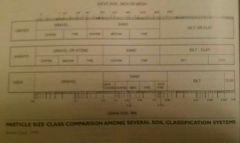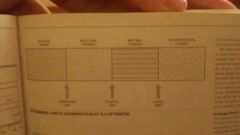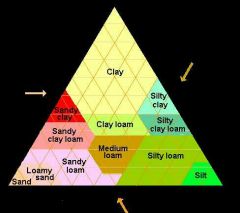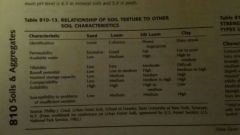![]()
![]()
![]()
Use LEFT and RIGHT arrow keys to navigate between flashcards;
Use UP and DOWN arrow keys to flip the card;
H to show hint;
A reads text to speech;
43 Cards in this Set
- Front
- Back
|
3 soil classification systems |

USCS: Unified soil Classification systemAASHTO: American Association of State Hwy and Transportation systemUSDA/ NRCS |
|
|
AASHTO |
American Association Of state Hwy and Transportation Officials Used for road construction. Two main categories: granular materials (A-1-A-3) that are excellent to good as a subgrade, and silt-clay materials (A-4-A07) that are fair to very poor as a subgrade |
|
|
USCS |
Unified soil classification system Cohesive soils (fine grain- contain clay) and Non-cohesive (coarse grain - lacking clay) Cohesive soils classified based on n plasticity, noncohesive based on texture. Organic soils are a third category not suitable for a foundation (i.e. peat soils) |
|
|
USCS 4 major grain Characteristic divisions |
Coarse grain Fine grain Organic soil Peat |
|
|
Soil system that differentiates silt and clay |
USDA |
|
|
Atterberg limits |

scale of water Content in soil related to engineering behavior |
|
|
Liquid limit ( upper plastic limit) |
water Content of soil when it Changes from a viscous liquid to a plastic body |
|
|
Plastic limit (lower plastic limit) |
The water content of the soil at which teh soil stiffens from a pastic to a semirigid or friable state |
|
|
Shrinkage limit |
The water content at which the soil change from a semirigid state to a rigid solid |
|
|
Plasticity index |
The range in water content when the soil exhibits plasticity; the difference between the liquid limit and the plastic limit |
|
|
hard or brittle soil |
at the shrinkage limit or drier |
|
|
friable |
soil moisture between the shrinkage and the plastic limit. Soil should only be worked if it is Friable |
|
|
Plastic |
soil moisture between the plastic and the liquid limit. More clay usually means a larger plasticity index. |
|
|
Montmorillonite clay |
High degree of expansion and contraction on wetting and drying, has a greater effect on increasing the plasticity index than illite (moderate expansion and contraction on wetting and drying) or kaolinite clay (low degree of expansion and contraction on wetting and drying) |
|
|
Effect of organic matter on plasticity |
Tends to reduce the effects of clay and the plasticity index, but if soil is extremely plastic it may have little if any effect |
|
|
Soil type that is usually non-plastic |
Sandy or non-cohesive soils |
|
|
Distribution of void space and solid matter in idealized planting soil |
Air: 25% Water: 25% Mineral particles: 45-48% Organic matter: 2-5% |
|
|
Phillip Craul's 8 characteristics of urban soils |
1. vertical variability caused by cutting and filling 2. Soil structure has been changed in some areas so that the crumbly aggregation of soil particles is crushed into an undifferentiated mass 3. soils often have an impervious crust that sheds water due to compaction and/or lack of vegetative cover 4. soil pH may be changed due to contaminants and to the runoff from built surfaces 5. macropores in the soil are destroyed by compaction impeding air and water drainage 6. soils often have interrupted nutrient and organic matter cycling due to the removal of decaying leaves and other vegetation 7. Urban soils often contain human junk like rubble from old foundations, basements and utilities 8. often intentionally separated from the earth on roofs or in planters and thus heat and cool more rapidly |
|
|
Adhesion & cohesion |
Adhesion is the force that attracts water to any solid surface. Cohesion is the force that attracts water to itself. As pores in soil get larger adhesive forces are weakened because water is farther from the solid surface. The amount of water heled against gravity increases as particle size gets smaller |
|
|
Field capacity |
The amount of water a soil can hold after the excess is allowed to drain away via gravity. At field capacity water can be taken up by plant roots or evaporated from the soil surface |
|
|
Permanent wilting point |
When no more water can move into the plant root due to adhesive forces in the soil |
|
|
Plant-available water |
Between the field capacity and the permanent wilting point |
|
|
Soil bulk density |
Measured in g/cubic centimeter. If bulk density is too high it can affect root growth. A sandy soil with bulk density greater than 1.6-7g/cubic cm can affect root growth, while in clay the number drops to 14. g/cm^3 |
|
|
3 ways to modify soil which is too compacted or poor to support plants |
1. remove and replace 2. amend 3. Bury under new soil |
|
|
When is it appropriate to bury poor soil under new soil |
Where soil sare heavy, poorly drained, or compacted, or when a high water table approaches rooting depth, or where underground obstacles limit rooting depth. |
|
|
Amending clay or poor soil with sand |
Adding sand into clay actually decreases pore space until the volume of sand exceeds 75%. Sand should not be well-graded; all particles should be within a narrow size range |
|
|
Organic amendments |
Apply if necessary over whole site, not just in planting hole. Need at least 25% by volume to affect bulk density. |
|
|
Structural soil |
stone matrix with narrow particle size distribution along with a soil mixture that has a minimum 20% clay and about 5% organic matter |
|
|
soil bearing capacity |
the capacity of soil to support the loads applied to the ground. The bearing capacity of soil is the maximum average contact pressure between the foundation and the soil which should not produce shear failure in the soil. Soil compacted at optimum moisture levels had greater shear strength |
|
|
CU-soil |
structural soil developed and patented by Cornell University. Specifying CU soil guarantees that the soil meets a predetermined standard specification |
|
|
How do structural soils affect plant selection? |
Can raise the pH of the soil so plants should tolerate alkaline conditions. Should also be drought tolerant and thrive in well-drained soils |
|
|
How much soil for good tree growth? |
Rule of thumb: 2 cubic feet for every square foot of canopy crown, range of 1-3 cu ft/sf of crown could be suitable |
|
|
Effect of climate on soil horizon formation |
horizon development is more well-developed in humid climates than arid climates |
|
|
USDA soil classification system |
Based on agricultural suitability, describes relative proportion of clay, silt, and sand within the soil. Limited to depths of about 1 m. |
|
|
Physical properties of soil |
Color: classified on Munsell soil chart Density: ie bulk volume Cappillarity: Upward movement of moisture or water above the water table Permeability: ability of a soil to transmit water downward Shrinkage & swell: buildup and release of capillary tenisle stresses within soil due to water. Expansive soils shrink and swell dramatically, making them unsuitable for building Cohesion: ability of a soil sample to bind together when moderately dry |
|
|
Elasticity |
Ability of soil to return ti its original shape after being deformed by a load |
|
|
Plasticity |
Ability of soil to be defored under pressure without cracking or crumbling and to maintain a deformed shape after pressure is released. Plastic deformation is an important factor in road and foundation work |
|
|
frost Susceptibility |
tendency to Swell due to frost . Higher in fine-grain soil |
|
|
Compressibility and Compaction |

|
|
|
Soil mottling |
Indicates drainage depth. The deeper the mottling the more well drained the soil |
|
|
Usda soil texture triangle |

|
|
|
Erodability |

Increases as % silt increases |
|
|
Soil texture relationship to characteristics |

|

